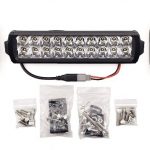Basically, all mulch offers the same benefits. However, one mulch offers an additional benefit that other mulches don’t. Eucalyptus mulch. It repels insects. Its insect repelling properties are inherit. So there are no special maintenance you need to perform. Nor do you need to apply special installation techniques to ensure that it works.
Items you will need to install Eucalyptus mulch include:
- Eucalyptus mulch
- Ruler or measuring tape
- Rake
It should be noted here that there is some controversy concerning Eucalyptus mulch. It is true that oil from the Eucalyptus tree does repel insects. There are some who say that mulch made of Eucalyptus itself has the same qualities. There are studies that show that Eucalyptus mulch does repel insects, especially termites. Other studies show that the mulch has no effect on insect activity. A third group of gardeners surmise that any repelling properties the mulch has only a temporary benefit of relief against insects and that benefit last only about three months.
Of course, the mulch itself does not harm your garden or lawn. So if you are adventurous and wish to perform you own experiment on the matter, then give the Eucalyptus mulch a try.

(Courtesy: Lien at flickr.com)
Is Eucalyptus Mulch Toxic To Plants?
If you are an experienced gardener, then you may have heard that Eucalyptus is toxic to plants. It appears that the toxicity is relatively short-lived.
Gardeners have been known to use Eucalyptus mulch because of its toxicity to pests and weeds. A substance called allelochemicals contained in Eucalyptus does have a negative effect on other living things.
So other gardeners are somewhat concerned about using it in their garden. The concern is based on the fact that some plants do not prosper when growing near Eucalyptus trees. So it makes sense that Eucalyptus mulch could pose a threat to plants.
According to the California Cooperative Extension Service, the toxicity of Eucalyptus mulch, commonly sold as chipped bark, is short-term. You are more likely to experience unwanted plant suppression due to the bulk of the bark and leaves shed from the Eucalyptus tree than from the allelochemicals. To calm concerns, make sure that the wood chips or leaves do not smother the plants. This can be avoided by placing the mulch away from the base of plants or rake or blow the material from the plants. It is also advised that you water your plants well to fight back any potential toxicity of fresh Eucalyptus litter.
The Help Desk of the University of California Master Gardener Program of Contra Costs County, California notes that research shows that well composted Eucalyptus leaves do not pose a threat when used as a mulch or when mixed in proper quantities into a growing medium. The research also shows that fresh Eucalyptus leaves were a good weed suppressant when applied to a depth of 4-inches.
The toxicity of Eucalyptus is rendered harmless during the composting process. This is especially true if you work a hot compost pile. When composting Eucalyptus, the leaves are considered green plant material and serves as the nitrogen part of the composting process. To assure that the Eucalyptus bark or leaves mix them thoroughly with carbon-based materials including newspaper, cardboard, or other dry leaves or plant material.
If you still have concern, then compost Eucalyptus litter into a separate hot compost pile. Keep the pile well moistened and turn it often to assure that the mix stays hot over a longer period of time.
Applying Eucalyptus Mulch
The mulch should be laid down more than 2-inches to 4-inches deep over the soil. It is suggested that you wait to install the substance until a lot of decomposition has occurred.
It is further suggested that you rake up existing inorganic mulch before applying the organic Eucalyptus mulch.
Spread the mulch on the ground and around the plants. Use a thinner layer than prescribed above if the soil shows signs of poor drainage that frequently puddles or becomes waterlogged. When spreading this mulch around trees, it is recommended that you spread it all the way out to the edge of the tree’s drip line.
The drip line is defined as the point on the ground where water drips off the widest-reaching branch. To determine the drip line, study the shape of the tree. Look for the widest part of the tree’s canopy and the widest-reaching branches on both sides.
Walk to that point and drive a stake into the spot. Do the same on the other side of the tree.
Place one end of a retractable measuring tape at the trunk of the tree and feed out the tape measure to the stake. Do the same on the other side of the tree. The largest number is the actual drip line in feet.
Take care to spread the mulch away from plant stems and tree trunks. You should leave a few inches of space between the mulch and the plant or tree. Don’t mulch up against a building. Common mulch is known to encourage termite activity. Although, as mentioned, Eucalyptus mulch repels these types of insects, it is still recommended that you keep the mulch at least 12-inches away from a building’s foundation.
It is recommended that you exam the mulch every year to be certain that it continues to maintain a depth of 2-inches to 4-inches. Add new mulch if its depth decreases during the year. If the mulch looks kind of shabby after one year, then rake it to revive it.
(Sources: homeguides.sfgate.com, homeguides.sfgate.com, gardenguides.com, hunker.com, and ucanr.edu)






